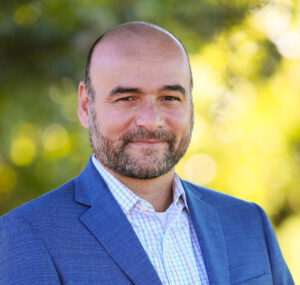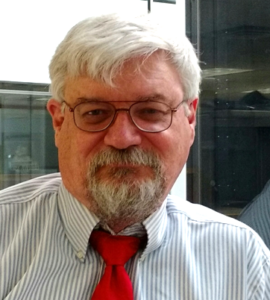Vela, Guzmán and Herrin raise quality-of-life concerns in race for District 4
Monday, October 21, 2024 by
Chad Swiatecki In the race for the District 4 seat on City Council, incumbent Chito Vela is facing four candidates, with the two most visible challengers – Monica Guzmán and Louis Herrin – notching their third and fourth races for City Council, respectively.
Quality-of-life issues are the main concerns expressed by Vela, Guzmán and Herrin, the three candidates the Monitor was able to interview (Eduardo Romero and Jim Rabuck did not respond to requests for interviews). The biggest difference among them is the terminology and anecdotes each uses to explain the future of the district, which is located northeast of downtown and generally bounded by Braker Lane, Dessau Road, Research Boulevard and Lamar Boulevard.
Sidewalks, walkability, transportation, parks and crime were the ingredients peppered throughout conversations with the three. Vela, who was elected to finish a partial term leftover when Greg Casar was elected to Congress in 2022, said the city needs to continue its installation of sidewalks funded by recent bond packages for transportation needs. With those funds nearly exhausted, he said the next bond election will need to address local infrastructure, possibly related to larger climate and sustainability projects.
“The one issue that constantly comes up across the district would be mobility issues, sidewalks, bike lanes and connections between different parts of the district. That’s all what I would call micromobility concerns that come up in meeting after meeting after meeting,” he said. “We have seen a number of sidewalks being installed throughout the district. That’s only fair because District 4 had not received its fair share of public resources for decades. We’re playing catch-up right now.” He said the district would likely need additional bond money for more sidewalk construction “as soon as possible.”

Photo courtesy of Chito Vela for D4 Campaign
Larger transportation needs that impact the whole city are another concern for Vela, who sees Project Connect as a must-have initiative that needs to be completed, despite the legal challenges being made against the funding and administrative mechanisms used to pass it in a 2020 election. Vela wants design and planning to continue while the legal battles continue, and is looking for state leaders who can back any legislation that could negate the legal clouds hanging over the project.
If the 2025 Legislature isn’t able to provide that solution, he said the city should consider a bond election that would more easily fund the capital costs that were included in the 2020 tax rate election.
“If we get through this next session and we don’t have a resolution, and the court case has not really advanced, and we’re still sitting there with all this uncertainty, we, meaning the city of Austin, may need to go back and try a plan B,” he said. “That bond election would be tax-neutral to the public, but it would just shift the amount and say, OK, the overall tax rate is the same, but now this amount is for maintenance operations, and this amount is for capital projects.”
As a frequent voice in favor of closing the Fayette Power Project coal-powered plant, Vela sees promise in moves by Austin Energy to secure solar contracts from local providers using rooftop systems throughout the city. He hopes those arrangements can bring more price stability for the city while meeting the needs on hot summer days when solar production is at a peak.
On the question of housing needs in the district and throughout the city, Vela sees the ongoing decrease in rents as evidence that the move for more apartment construction is gradually helping to solve the ongoing affordability crisis. For single-family homes, he said policies such as the HOME and HOME2 initiatives will likely take longer to affect housing prices.
“In the next five years, I don’t think that the HOME ordinances will have a huge impact on the look and feel of the city, and on prices for new single-family homes. Over the next 20 years, I think they will have a major impact on what the city looks and feels like,” he said, noting that the passage of pro-accessory dwelling unit policy almost a decade ago has only had a modest effect in the district.
He also downplayed the concerns over the possible property tax increases some see as a coming side effect of the push for density: “When you do a broad rezoning like that, you don’t really see those concentrated impacts. You tend to see a much more muted impact in terms of property tax values.”
Monica Guzmán, a local organizer and the policy director for Go Austin/Vamos Austin, or GAVA, said residents in many portions of the district face a lack of walkable areas and nearby parks, especially those in apartment complexes around Lamar Boulevard, which can be difficult for some to cross.

Photo courtesy of Monica Guzmán for D4 Campaign
“Lamar and Rundberg is still one of the deadliest intersections in the city when it comes to auto and auto-pedestrian accidents, but I would say we need more parkland, more sidewalks, and we need more urban canopy, especially with high density structures, whether it’s a mixed-use with retail on a first floor and residential above it, or just an apartment complex,” she said.
“There’s not enough green space for kids to play on. That’s definitely something that we really need, especially with climate change and needing to plan with that. We need more trees, parkland and green space.”
Affordable housing is one of Guzmán’s most serious concerns for the area. She said if elected she’d partner with other Council members representing the city’s Eastern Crescent communities to push for the creation of more housing priced for low- and middle-income households.
“Most of them are tax credit properties, and so they will stay income-restricted for several years. But at the end of that time period, whether it’s 30, 40 or more years, the owner can flip it to make it all market rate, which would potentially displace the residents who are in there at the time that is done,” she said. “We want to preserve that, have a relationship with the property owners and with management to encourage them to keep it income-restricted in perpetuity. Then also see about adding more, especially the rental properties that are income-restricted.”
Other quality-of-life issues Guzmán wants to see addressed include the creation of neighborhood circulator routes to help residents have better access to the limited number of full-service grocery stores in some areas. She also pointed to the increased visibility of open drug markets and sex workers spreading north on Georgian Drive as an issue that the Austin Police Department and Austin Independent School District need to work together to address.
Those issues as well as the needs of those experiencing homelessness tie into Guzmán’s belief that the city should pivot its public safety resources further into community and mental health, with case workers and related professionals able to produce better results than the police officers and paramedics who respond to the bulk of 911 calls. Extending that philosophy, she would like to see the APD budget held flat for at least another year so the money to fund the raises called for by the proposed Austin Police Association contract could be directed elsewhere.
“’I’m not saying that the police aren’t needed, or EMS or fire. They are all needed, but our police are responding to calls for things that should be responded to by other folks who are appropriately trained,” she said. She added that the $80 million Community Investment Budget called for by an assortment of community groups could have easily been funded with a fraction of the police budget.
“Eighty million was tons of money, but a drop in the bucket compared to the whole budget. Being told that there’s no money and we’re facing a deficit, yet all of a sudden more than $200 million has been found for use for across five years – it just raises red flags.”
For Louis Herrin, who works as an engineer for the Texas Commission on Environmental Quality, a stronger police force and a shift to community policing are necessities for the district he said has seen a rise in larcenies and other crimes that don’t attract major attention from city leaders.

Photo Courtesy of Louis Herrin Campaign
“Even though they’re saying the statistics are going down,” he said, “if somebody comes in, walks into my garage to steal my tools, I’m not calling 311 anymore because we know nothing’s going to happen. I think that’s what a lot of people have the feeling.”
“When I ran 10 years ago, I pushed for community policing, where we have officers that are basically assigned to a certain community. They interact with the community, they get out of their cars, they talk to people, and we have basically a two-way conversation. I don’t see that happening because we’re understaffed.”
Herrin said parks throughout the area need more attention and features to make them family friendly, with neighborhood groups often taking up the bulk of the work to mow and maintain the areas.
Looking at City Hall, Herrin said a comprehensive audit of city operations and finances is needed to identify inefficiencies and waste. He pointed to the many levels of permitting and planning approvals needed to build a home as an example of redundancy he’d like to eliminate.
“It needs to be independent because I want them to show where we’re duplicating things, where we need more staff, where we have too much staff, and where we’re doing stuff that we shouldn’t be doing,” he said.
“One of the things I suspect that will come back is a lot of the city pet projects will be going away. But that is one of the things I think we can probably save money on that big time.”
Herrin doesn’t spare his criticism of the Project Connect mass transit plan, the cost of which he said was lowballed to win support from voters. With the costs increasing and the scale of the first phase shrinking, he said a better approach to transit would have been prioritizing commuter lines into the city from surrounding suburbs to take more long-distance travelers off the road.
If elected, Herrin said he’d be pointed in his views and wouldn’t join a bloc of similarly minded officials on the City Council dais.
“I don’t have a problem calling somebody out when I have a disagreement with them. I will explain my side and I would expect them to explain their side. When everybody has the same mindset, there is no compromise, and it leads to corruption … when somebody’s calling to put a pet project up, I’m going to say no, because we need to go back to the basics.”
The Austin Monitor’s work is made possible by donations from the community. Though our reporting covers donors from time to time, we are careful to keep business and editorial efforts separate while maintaining transparency. A complete list of donors is available here, and our code of ethics is explained here.
You're a community leader
And we’re honored you look to us for serious, in-depth news. You know a strong community needs local and dedicated watchdog reporting. We’re here for you and that won’t change. Now will you take the powerful next step and support our nonprofit news organization?










